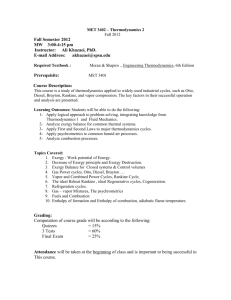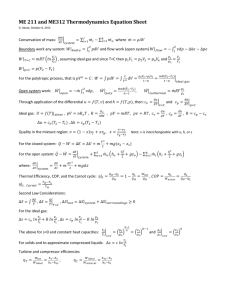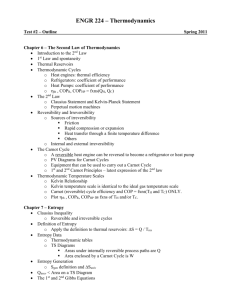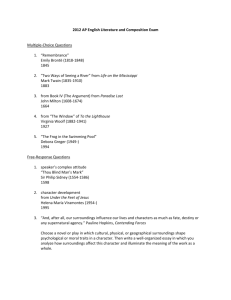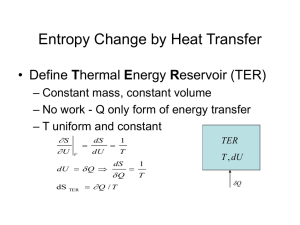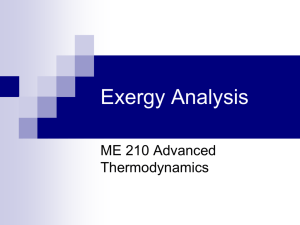MER26_Thermo_review
advertisement
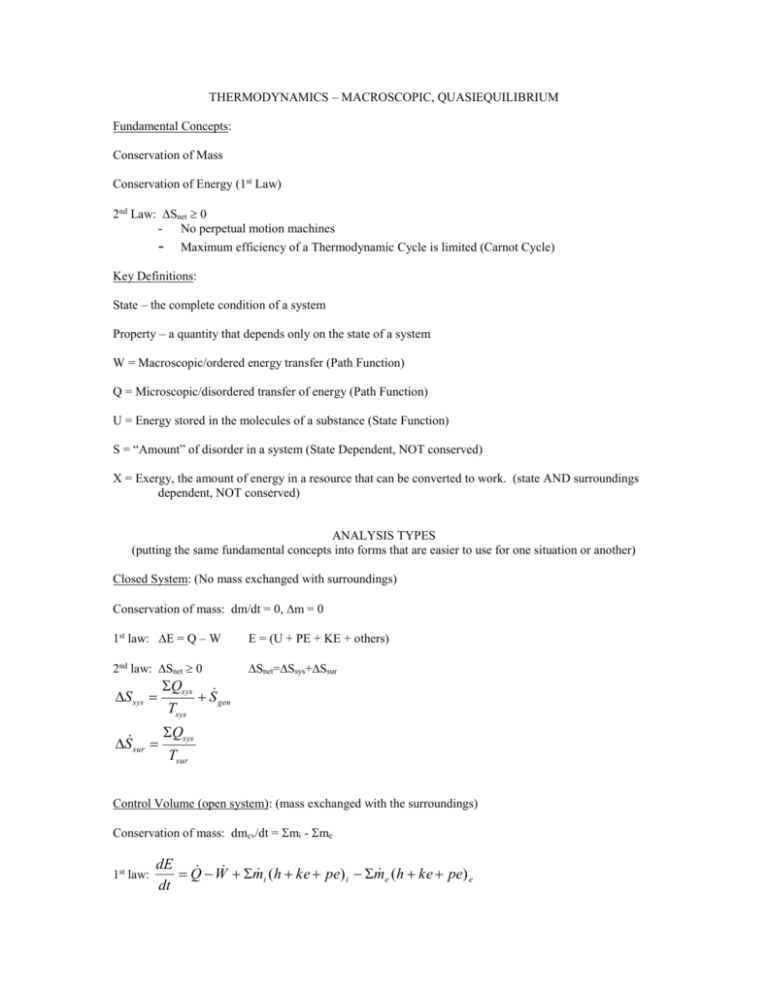
THERMODYNAMICS – MACROSCOPIC, QUASIEQUILIBRIUM Fundamental Concepts: Conservation of Mass Conservation of Energy (1st Law) 2nd Law: Snet 0 - No perpetual motion machines - Maximum efficiency of a Thermodynamic Cycle is limited (Carnot Cycle) Key Definitions: State – the complete condition of a system Property – a quantity that depends only on the state of a system W = Macroscopic/ordered energy transfer (Path Function) Q = Microscopic/disordered transfer of energy (Path Function) U = Energy stored in the molecules of a substance (State Function) S = “Amount” of disorder in a system (State Dependent, NOT conserved) X = Exergy, the amount of energy in a resource that can be converted to work. (state AND surroundings dependent, NOT conserved) ANALYSIS TYPES (putting the same fundamental concepts into forms that are easier to use for one situation or another) Closed System: (No mass exchanged with surroundings) Conservation of mass: dm/dt = 0, m = 0 1st law: E = Q – W E = (U + PE + KE + others) 2nd law: Snet 0 Snet=Ssys+Ssur S sys Ssur Qsys Tsys S gen Qsys Tsur Control Volume (open system): (mass exchanged with the surroundings) Conservation of mass: dmcv/dt = mi - me 1st law: dE Q W m i (h ke pe) i m e (h ke pe) e dt 2nd law: S net 0 S net SCV S sur Qcv S gen Tcv Qcv m i si m e se Tsur SCV m i si m e se Ssur These equations can be written in SSSF (steady state, steady flow), USUF (uniform state uniform flow) or “other” forms SSSF: d (anything ) 0 dt d (anything ) endstate initialsta te . m “dots” become just “m’s” dt mcv 2 mcv1 mi me USUF: m2 (u2 ke2 pe2 ) m1 (u1 ke1 pe1 ) Q W mi (hi kei pei ) me (he kee pee ) TdS relations: (the first law, in differential form, expressed in terms of properties only) Tds = du + Pdv Tds = dh - vdP “TOOL BOXES” (we use a lot of stuff from previous classes … you must remember it) 1) General Physics - F=ma - F.B.D.s - F=-kx (linear spring) - WFdx = PdV for moving boundary work (note: must use calculus here!) - KE = ½ mv2 - Other stuff that you thought was OK to forget, but isn’t 2) MATH - know how to integrate, and when an integral is required! W=PdV Find P(V) and THEN INTEGRATE! Ex: P=c/V W = c/V dV = cln(V) - Know how to graph functions: P,v T,v & T,s plots - Remember, you need the same # of equations and unknowns Before trying to solve! 3) UNIT ANALYSIS - ALL Terms in EVERY Equation must have the same units! If they don’t your equation is wrong. Keep track of units, it will let you spot mistakes early. NEW TOOL BOXES ... Developed in this class ... don’t forget them! 4) Property Relationships (Equations of state for simple compressible substances) * Remember: For a simple compressible substance it only takes two (2) independent intensive Properties to “Fix” the state. (v,x,u,h,s & P,T) Be Careful of P&T they are not always independent. Once the state is Fixed ALL other properties are known (if you know where to look!) Ideal Gas or Tables? (these are two ends of a spectrum …. from most approximate to most exact about the behavior of simple compressible substances) IDEAL GAS: Far From the Steam Dome (Remember “true” ideal gasses are strictly hypothetical … we made MANY assumptions to simplify the world down to this level … but often it is an adequate model for what we are trying to do) - PV=mRT or Pv=RT (any ideal gas) - cp-cv = R Ideal Gas with CONSTANT specific heats - u = cvT - h= cpT - s = cvln(T2/T1) + Rln(v2/v1) 0R s = cpln(T2/T1) - Rln(P2/P1) For better accuracy use cp(T) and cv(T) …. then the above three equations all involve integrals! We also learned how to come up with meaningful averaged properties for mixtures of ideal gasses using the mass fraction (mi/mmix) or the mole fraction (Ni/Nmix). In fact that is how the “properties” of air which are found in your text were arrived at (air is simply a mix of ideal gasses) COMPRESSIBILITY FACTOR, Z: Can be used as a “patch” to improve accuracy of IG equation - Pv=ZRT Find Z in terms of “Reduced” properties: P r=P/Pcp Tr=T/Tcp cp = critical point “REAL SUBSTANCES”, TABLES - Thermodynamic Tables and Charts: Know how and when to use them! - Always start at the Saturated Tables and work from there - Know the meaning of quality (x. x=mvap/mtot), and how to use it to get saturated mix properties (e.g. v = vf+xvfg) - Remember that compressed liquids can be modeled as saturated liquids AT THE SAME T 5) KEY ASSUMPTIONS and OTHER STUFF - SSSF No Change Over time ( )/t = 0 - Adiabatic Q = 0 - Reversible No Losses (friction, mixing etc.) - Reversible AND Adiabatic together yield Isentropic No change in Entropy - m VA VA / v (Very useful, often forgotten) Intensive vs. Extensive Properties, Be confident switching back and forth (ex: V/m = v) 6) 2nd LAW TOOLS *NEW, LEARNT IN THIS CLASS - “Entropy” is a measure of the disorder in a system - INCREASING ENTROPY * Snet = 0, Reversible * Snet > 0, Irreversible * Snet < 0, Impossible Remember “net” means system + surroundings * Inequality of Clausius Q T 0 * dQ TdS … the equal sign is for the reversible case * A net entropy increase causes a process to be irreversible. * A reversible process is always the most efficient process * Things which cause processes to be irreversible are known as irreversibilities. These include: - Friction - Unrestrained expansion (expansion without extracting work) - Heat Transfer ACROSS A NON-ZERO TEMPERATURE CHANGE - Mixing - THERMAL EFFICIENCY th What you Want / What You Pay For (called C.O.P. for fridge and Heat pump) carnot = 1- Tl/Th , This is the highest Thermal efficiency possible for any heat engine cycle! (T in K) ISENTROPIC EFFICIENCY s What you get/ the best you could get if no losses (typically isentropic, sometimes Isothermal for compressors) EXERGY: Gives the MAXIMUM amount of work that we could extract from a “resource” in a given set of surroundings. To specify exergy you must specify the system (resource) state AND the Dead (useless, in thermal equilibrium with the surroundings state) - Anything which is not in thermodynamic equilibrium with its surroundings (dead state) will have positive exergy. (even something colder than the surroundings could be used as a heat sink, and hence gives the opportunity to produce work) - The change in exergy between two states is equal to the maximum (reversible) amount of work that could be extracted for that change of states. - Exergy is not conserved ... it can be destroyed. Whenever there are irreversibilities in a process, exergy is destroyed in the process. The reverse of this statement is also true ... whenever exergy is destroyed there is irreversibility. When ever exergy is destroyed the net entropy increases. What we chose to study (using our new tools) Closed systems: (primarily a learning tool … most real devices are CV’s) - Rigid vessels … V = constant - Piston Cylinder Arrangements … use FBD’s to help solve problem - Moving Boundary Work = Pdv - get path from FBD and integrate for piston cylinder. = 0 for Ridged vessel (because Δv = 0) Steady State Devices: Turbine: turns enthalpy to Work Nozzle: turns enthalpy to Kinetic energy Compressor: the opposite of a turbine turns work into increased gas pressure (enthalpy) Diffuser: the opposite of a Nozzle, turns kinetic energy into increased enthalpy (pressure) Pump: Like a compressor, but works on “incompressible liquids.” Because of this the expression w=-∫vdP (for a steady state, reversible work) becomes very easy to calculate as just w=-vΔP. This is the easiest way to calculate pump work. Throttling valve: An irreversible, but cheap, way to lower the pressure. Boiler / Evaporator: A heat exchanger that takes heat into the working fluid at constant pressure and causes a phase change to occur. No work is done. Condenser: A heat exchanger where heat is rejected from the working fluid at constant pressure and causes a phase change to occur ... again no work is involved. By using these devices in various combinations we can build up many useful cycles. CYCLES: ANY set of thermodynamic processes that forms a closed loop - U = 0 …. closed loop … when you get back to the original state no property can have changed - THEREFORE Wnet = Qnet. where Qnet = Q in – Q out … same for Work TH QH Wnet QL TL With regard to cycles the Second law Specifies that it is impossible to: 1) Create useful work with a cycle while exchanging heat with only one thermal reservoir 2) Move heat from a cold to a hot reservoir without providing (doing) work. CYCLES are typically used in one of THREE ways: - Heat engine … extract heat from a high temp source and make some of it into Work (the remainder gets dumped to a low temp source) W is what you want … Q h is what you pay for (a heat engine schematic is what is shown above) 1 QL QH - Refrigerators … use work to extract heat from a cold place … the energy is then dumped to a warmer place. QL is what you want Wnet is what you pay for (Air conditioners are the same as refrigerators) COPR 1 QH 1 QL - Heat Pumps … use work to extract heat from a cold place and then USE that heat to heat a warm place. QH is what you want … Wnet is what you pay for COPHP 1 Q 1 L QH SPECIFIC CYCLES THAT WE LOOKED AT: CARNOT CYCLE: The most efficient cycle allowed by law! (the second law, that is) This one is theoretically VERY important … it gives us a way to calculate the upper bound on the efficiency we can actually obtain. Engineers use this as an IDEAL … but we never really try to build these… they are impractical. A CARNOT CYCLE IS A REVERSIBLE CYCLE. Any two reversible cycles operating between the same two temperatures will have the same efficiency. Any irreversible cycle operating between those same temperatures will have an efficiency LESS than that for a reversible cycle. - A carnot cycle is composed of two ISOTHERMAL Processes and two ISENTROPIC processes as shown below. T s - For a CARNOT cycle the RATIO QL/QH = TL/TH in the cycle (thermal) efficiency formulas. This only works for Carnot or Reversible cycles!!! RANKINE CYCLE: Practically VERY important … this is how we make most of our electricity - anything that increases the average temperature at which heat (T H) is added will improve efficiency … raising the Boiler Pressure and Superheating the steam both do this - anything that will decrease the average temperature at which heat is rejected (T L) will improve the cycle efficiency … lowering the temperature in the condenser does this. - The REHEAT and REGENERATIVE Cycles are both ways to increase the efficiency of a Rankine cycle, without running into the problem of too much Liquid in the Turbine. *** Your book has a good description of the Rankine Cycle (and Reheat, cycles … Please READ it) VAPOR REFRIGERATION CYCLE: Basically this is a Rankine cycle run in reverse. Typically the turbine is replaced with a throttling valve, because they are much cheaper than turbines ... but this does introduce irreversibilities and harm efficiency. OTTO CYCLE: The idealized version of the Gasoline internal combustion engine cycle. The efficiency of the ideal otto cycle depends only on the Compression Ratio (r) , and the ratio of cp/cv (k) (which depends on the fuel/air mix used). otto 1 1 r k 1 . The maximum compression ratio is limited by the problem of “knock” or auto-ignition. The efficiency of real gasoline engines is hurt by the fact that a Throttling Process is used to reduce engine output for part load conditions. The Throttling process is irreversible and hence inefficient. DIESEL CYCLE: This cycle was basically designed to try to address some of the inefficiencies of the Otto cycle. Also called a “compression ignition” engine. The fuel and air are NOT premixed, and this eliminates the problem of “knock” so higher compression ratios can be used. Also, control of the quantity of fuel burned is what limits power at part load conditions ... therefore there is no need for an inefficient throttling process. Diesel engines are more efficient, but they have a more limited operating range of engine speed, and hence lower overall performance. (Again, the tradeoff between efficiency and performance raises its ugly head!) diesel 1 1 r ( k 1 rck 1 ) k (rc 1) BRAYTON CYCLE: This is the idealized version of a “gas turbine” or jet engine cycle. This cycle is becoming increasingly popular for stationary power development, due to its high efficiency, and the fact that it can easily be combined with a Rankine cycle to come up with a very efficient “combined cycle” for electricity generation. The other major use of this cycle is in propulsion, where it is used as a primary power source for large ships and, of course in Jet Engines. In Jet engine use the energy is extracted as Kinetic energy, rather than as shaft work. Brayton 1 1 r ( k 1) / k p

